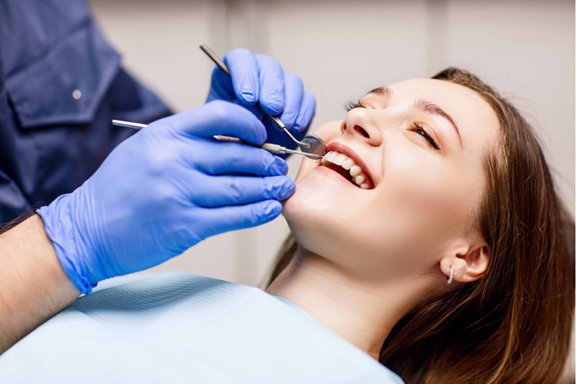Mouths are notoriously bacteria-laden, and that’s not always a bad thing. Bacteria are essential to a healthy oral environment, helping you digest your food, protecting your teeth and gums, and keeping your breath fresh. In fact, over 700 different types of bacteria thrive in your mouth in what’s called an oral microbiome.
But if they’re untended, these bacteria flourish and multiply, taking over in unhealthy ways. It’s vital to balance good and bad bacteria, which is where an ultrasonic teeth cleaner can help.
When you put something in your mouth, whether it’s food, your toothbrush, or your night guard, bacteria are on it. How you care for the item determines its cleanliness and how many microorganisms live on the surface. Ultrasonic teeth cleaners use innovative technology involving high-frequency sound waves to remove these germs from the item and your teeth.
How do you know which type of ultrasonic cleaner you should buy? We’ll review the options here to help you decide.
1. Plaque and Tartar Removal
The first step in a healthy oral microbiome is to ensure you remove plaque and tartar from your teeth and gums. An ultrasonic toothbrush does this job better than a manual brush.
This device is gentle on your enamel and gums, making it safe for all ages. You can find a variety of brands and designs on the shelves at your favorite drugstore.
As you’re looking for the best ultrasonic toothbrush for your unique needs, check the bristles. Most dentists recommend soft bristles to prevent damage to your sensitive gum tissue, but your dental health might need medium or firm.
The typical ultrasonic toothbrush comes with a removable head. Factor in the cost of the original brush and these replacement heads when you’re making your final decision.
If you travel a lot, you’ll want to consider investing in an ultrasonic teeth cleaner that is easy to take apart and store in your purse or luggage or is already travel-sized.
2. Oral Appliance Care
Finding ways to keep your oral appliances, such as retainers and night guards, free from extra germs can be a challenge. By nature, these devices are designed to go into and out of your mouth, where they’ll be covered in bacteria.
When you leave the device sitting in the bathroom or in a dark, humid place, those microorganisms multiply. Then, you put the appliance back in your mouth, where the bacteria are back in their favorite environment once again.
It’s an endless cycle that usually results in you getting sick from the germs covering your appliance. But this can be prevented if you take care of the device and store it carefully.
Most manufacturer’s instructions will warn you not to store your oral appliance in a humid, dark place, especially not the bathroom. They will also give you directions on how to clean the appliance using denture cleaner or toothpaste. But the best way to get rid of all of those pesky extra bacteria is to invest in an ultrasonic cleaner.
Using the same high-frequency sound waves as the toothbrush technology, this cleaner ensures every nook and cranny of your night guard or retainer is scrubbed free of germs. You can even deep clean your toothbrush head to make it last longer!
As a bonus, you don’t need chemicals; just add water. While you shop, be cautious about the complexity of the device. Some of these cleaners are complicated and full of extra features that are not necessary. The best devices are simple:
- Fill them with water to the max line.
- Put your appliance in the water.
- Press the ‘Start’ button.
For more about ultrasonic appliance cleaners, check out this article by JS Dental Lab.
3. Denture Cleanings
Similar to oral appliances but with a very different design, dentures, too, are in-and-out devices that need regular cleaning. Dentures are a haven for bacteria, plaque, tartar, and viruses.
You can clean them with OTC denture cleansers. However, since wearing dirty dentures can result in gum infections, respiratory problems, aspiration pneumonia, or heart disease, it’s vital that you perform a regular deep clean, too.
Ultrasonic denture cleansers are specially designed to care for the common materials making up dentures. They’re vibrating water baths that use high-frequency bubbles to clean the surfaces and hidden edges of your oral appliance. The machines are also built to allow sterilizing tablets for an extra deep cleanse.
Traditional methods of cleaning dentures leave behind microorganisms, whereas ultrasonic cleaning eliminates all of the debris and germs. Boiling water may eliminate these bacteria, but it will distort the plastics in your dentures. Ultrasonic cleansers use room-temperature water, allowing you the peace of mind of knowing your dentures are squeaky clean and safe from damage.
As you shop for this device, look for designs that allow you to empty a removable tank to prevent machine corrosion. When the parts get wet due to faulty designs, your machine won’t last as long. It’s also a good idea to find a machine that lets you separate your dentures without rubbing them together, which can cause damage to oral appliances.
Lastly, if you check out this dentist in Vienna VA now, they’ll advise you to consult a dental health professional for advice on which ultrasonic teeth cleaner is best and safe for your dental situation. Doing will ensure you’re getting the most out of the product.
Conclusion
Whatever your dental needs are, if you’re going to put something in your mouth, it must be clean. An ultrasonic teeth cleaner ensures this happens! Whether you need a toothbrush, an appliance, or a denture cleaner, there’s an ultrasonic device for you.


 Home
Home









